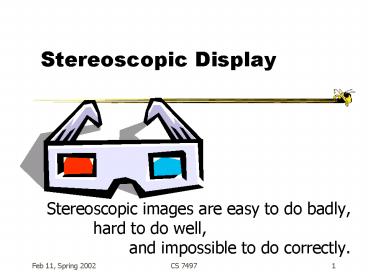Stereoscopic Display - PowerPoint PPT Presentation
1 / 27
Title:
Stereoscopic Display
Description:
where p is the amount of screen parallax for a point, f1, when projected onto a ... Different convergence angles can all have the same screen parallax. ... – PowerPoint PPT presentation
Number of Views:501
Avg rating:3.0/5.0
Title: Stereoscopic Display
1
Stereoscopic Display
- Stereoscopic images are easy to do badly, hard to
do well, and impossible to do correctly.
2
Stereoscopic Displays
- Stereoscopic display systems create a
three-dimensional image (versus a perspective
image) by presenting each eye with a slightly
different view of a scene. - Time-parallel
- Time-multiplexed
3
HMD Stereo (Time Parallel)
Combined View
Eyes
Optics
Screens
4
Time Multiplexed Display
- Left and right-eye views of an image are computed
and alternately displayed on the screen. - A shuttering system occludes the right eye when
the left-eye image is being displayed and
occludes the left-eye when the right-eye image is
being displayed.
5
Stereographics Shutter Glasses
6
Eye Facts
- Stereopsis - the result of the two slightly
different view of the external world that our
laterally-displaced eyes receive. - Stereoacuity - the smallest depth that can be
detected based on retinal disparity. - Visual Direction - Perceived spatial location of
an object relative to an observer.
7
Retinal Disparity
- If both eyes are fixated on a point, f1, in
space, then an image of f1 if focused at
corresponding points in the center of the fovea
of each eye. Another point, f2, at a different
spatial location would be imaged at points in
each eye that may not be the same distance from
the fovea. This difference in distance is the
retinal disparity.
8
Convergence Angles
- ?acbd 180
- ?cd 180
- ?-? a(-b) ?1?2 Retinal Disparity
f1
a
D1
f2
b
D2
a
b
c
d
?2
?1
i
9
Disparity
- If an object is closer than the fixation point,
the retinal disparity will be a negative value.
This is known as crossed disparity because the
two eyes must cross to fixate the closer object. - If an object is farther than the fixation point,
the retinal disparity will be a positive value.
This is known as uncrossed disparity because the
two eyes must uncross to fixate the farther
object. - An object located at the fixation point or whose
image falls on corresponding points in the two
retinae has a zero disparity.
10
Horopters
- Corresponding points on the two retinae are
defined as being the same vertical and horizontal
distance from the center of the fovea in each
eye. - Horopter - the locus of points in space that fall
on corresponding points in the two retinae when
the two eyes binocularly fixate on a given point
in space (zero disparity).
Vieth-Mueller Circle
11
Screen Parallax
The screen parallax is the distance between the
projected location of P on the screen, Pleft,
seen by the left eye and the projected location,
Pright, seen by the right eye.
12
Screen Parallax (cont.)
- p i(D-d)/D
- where p is the amount of screen parallax for a
point, f1, when projected onto a plane a distance
d from the plane containing two eyepoints. - i is the interocular distance between eyepoints
and - D is the distance from f1 to the nearest point
on the plane containing the two eyepoints - d is the distance from the eyepoint to the
nearest point on the screen
13
Screen Parallax and Convergence Angles
- Screen parallax depends on closest distance to
screen. - Different convergence angles can all have the
same screen parallax. - Also depends on assumed eye separation.
14
Setting Up Projection Geometry
No
Look at point
Eye Locations
Yes
Eye Locations
Look at points
15
Stereoscopic Voxels
16
Accommodation/ Convergence
Display Screen
17
Screen Size
The size of the window does not affect the
retinal disparity for a real window.
Once computed, the screen parallax is affected by
the size of the display screen
18
Visual Angle Subtended
Screen parallax is measured in terms of visual
angle. This is a screen independent measure.
Studies have shown that the maximum angle that a
non-trained person can usually fuse into a 3D
image is about 1.6 degrees. This is about 1/2
the maximum amount of retinal disparity you would
get for a real scene.
19
Position Dependence
20
Eye Separation Dependence
21
Point of fixation
Change in eyepoint separation with change in
point of fixation. Centers of rotation of the
eyes are assumed to be 6.4 centimeters apart.
22
Position and Eyepoint Dependence!
If you use an eye separation distance that is not
exactly the eye separation of the user then, with
head-tracking, the image is going to
be unstable. BUT, if you use the real eye
separation in computing the screen parallax most
users will not be able to fuse the stereoscopic
image.
23
Ghosting
- Affected by the amount of light transmitted by
the LC shutter in its off state. - Phosphor persistence
- Vertical screen position of the image.
24
Ghosting (cont.)
Luminance of the correct eye image ---------------
--------------------------------------------- Lumi
nance of the opposite eye ghost image
Extinction Ratio
Image Position Red White Top 61.3/1 17/1 Mid
dle 50.8/1 14.4/1 Bottom 41.1/1 11/1
25
Ghosting (cont.)
- Factors affecting perception of ghosting
- Image brightness
- Contrast
- Horizontal parallax
- Textural complexity
26
Refresh Rate versus Resolution
- Current raster graphics workstation stereoscopic
display techniques half the screen resolution in
order to double the image update rate. - Gives the equivalent of four frame buffers
- Complex images are not as detailed
27
Time-parallel stereoscopic images
- Image quality may also be affected by
- Right and left-eye images do not match in color,
size, vertical alignment. - Distortion caused by the optical system
- Resolution
- HMDs interocular settings
- Computational model does not match viewing
geometry.































